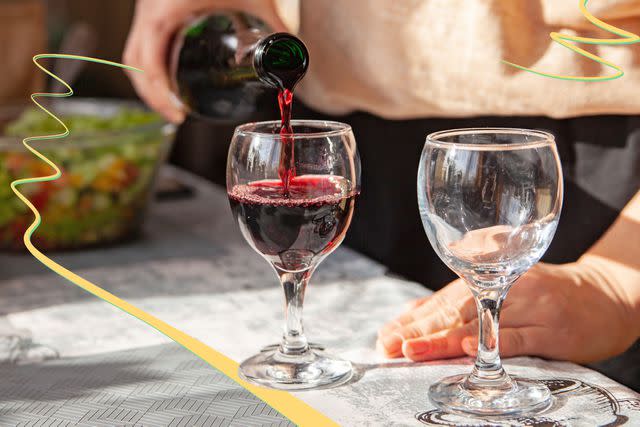For Better Wine, Try This Zero Dollar Trick
Find out why, when, and how to employ this easy—and free!—technique.

Simply Recipes / Getty Images
Every couple of years, I decide I need to learn more about wine, both for my job as a food writer and editor and simply for pleasure. So I'll take classes, go to tastings, read about wine, visit vineyards if I can, and buy new bottles to try. Along the way, I picked up a simple trick that can improve the quality of many types of wine: decanting.
Decanting might sound fancy, but it's just pouring wine from the original bottle into another vessel. You don't even need to buy a special decanter (more on that below). It has many benefits for the aroma, flavor, and even the texture of wine. The only tricky thing about decanting is that it's not always a good idea.
To learn more about why, when, and how to decant wine, I talked to Julia Burke, a wine buyer and events and education manager at Flatiron Wines in New York City, whom I first met when I took a class she taught about (extremely delicious) Pacific Northwest wines. Read on for the details.

What Is a Wine Decanter?
According to Burke, there are three reasons to decant your wine: to aerate the wine and unlock its aromas and flavors, to separate any sediment that might be in the bottle, and because it's fun.
Classic decanters are typically made of glass and are hourglass-shaped with a wider base than the top. These days, decanters come in all sorts of interesting shapes and styles.
"A decanter's unique shape exposes wine to oxygen efficiently by creating a larger surface area than a wine glass or an opened bottle," says Burke.
How to Properly Use a Wine Decanter
"If you are using a decanter to separate wine from sediment, ideally you can plan ahead and store the unopened wine bottle upright (rather than on its side) for 24 hours so that the sediment will settle at the bottom of the bottle and it's relatively easy to pour the wine into the decanter while leaving the sediment behind," Burke advises.
"Regardless of the reason you're decanting, once you open the bottle of wine you wish to decant, it's important to work slowly and carefully—you don't want to kick up the sediment or spill any of that precious wine! Pour the wine into the decanter, tilting the decanter and keeping the bottom of the wine bottle as low as possible so the sediment stays at the bottom."
Burke adds that while most people will serve wine from the decanter, others like to pour the wine back into the bottle so they can serve it from the original bottle. "If you're confident you can do that without losing any, go for it," she says.
After you're done with your decanted wine, Burke says to clean your decanter thoroughly and store it covered so it doesn't gather dust. There are bendable cleaners to help clean decanters with hard-to-reach spots.
Should All Wines Be Decanted?
"Definitely not," says Burke. "I rarely decant wines under $20, because there aren't usually enough layers of aroma and flavor complexity to justify the extra step. I don't decant inexpensive sparkling wines. And this is the most important rule: I don't decant very old wines unless the producer knows what vintage I'm drinking and recommends it. Over-exposure to oxygen for a fragile, delicate old wine can shut it down—for good."
When in doubt, Burke recommends talking to the experts at your local wine shop, the producer who made the wine, or another trusted wine professional for guidance about the specific wine.

Simply Recipes / Getty Images
What If You Don't Have a Decanter?
If you want to experiment with decanting but don't want to invest in a decanter, you have options. "I have always had decent results pouring wine from one large glass into another, or pouring it into a pitcher," says Burke.
"For a more subtle effect where I'm just 'waking up' the wine a bit, I just pour a glass out of the bottle and then let the bottle sit out with a few ounces removed so the fill line is lower."
As for the trend of using a blender to aerate wine by hyper-decanting it, Burke isn't sold. "I wouldn't use a blender, but I'm not Connor Roy," she jokes.
How Long Should a Wine Stay in a Decanter?
Once you've decanted a wine, the amount of time you'll want to wait before drinking it depends on the wine and the reasons for decanting, says Burke.
"If you just want to remove sediment, the wine will be ready to serve once in the decanter," she says. "If you are trying to aerate the wine, 20 to 30 minutes does wonders for the vast majority of decantable wines. In most cases the benefits start to dwindle after about an hour, or two hours for the most dense red wines, and the risk of over-decanting begins to rise after that."
Burke cautions that you can't leave wine in a decanter indefinitely, or it will turn into vinegar. "If someone tells you they decanted a wine for three days, be wary," she says. Ask your local wine shop for guidance if you're unsure about how long to decant a specific wine.
The Takeaway
With an initial investment in a decanter or simply by using a pitcher you already have, you can vastly improve the flavor of some wines without spending an extra cent. Decanting also helps remove sediment that can gather at the bottom of a wine bottle. When in doubt, check with your local wine purveyor about whether a specific bottle of wine should be decanted. Now go forth and unleash your inner wine snob on your family and friends—they'll no doubt be thrilled to hear everything you've learned about decanting, or at least they'll be happy to drink nice decanted wine with you.
Read the original article on Simply Recipes.

